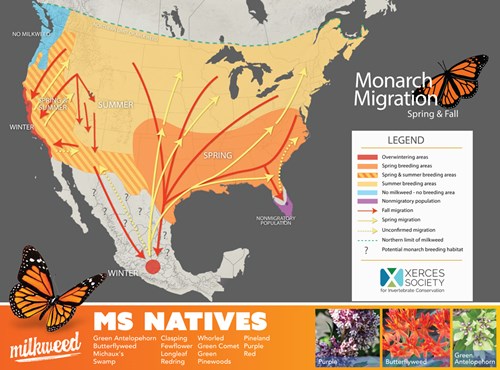Monarch Rule
10/9/2019 2:03:07 PM
By Dr. Audrey Harrison
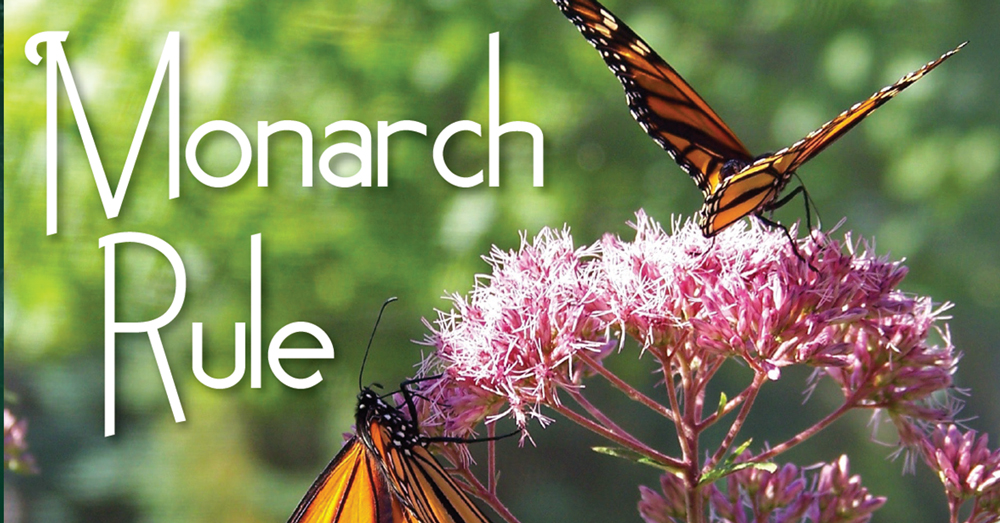
Many are familiar with the annual migrations of songbirds, hummingbirds, and waterfowl that travel from the tropics, across the United States, and back again. Seasonal movement allows animals to escape unfavorable weather, exploit new food resources, or reproduce. Most insects avoid unfavorable conditions, such as freezing weather, by entering a state of dormancy reminiscent of hibernation during winter. A handful of insect groups escape unfavorable conditions through large-scale migrations. The Monarch butterfly is one of the most iconic migratory insects.
Each fall in North America, Monarchs embark on a 2,500-mile journey from Canada to central Mexico. The fall migration typically begins in early August in southern Canada, and migrants move south throughout the United States in September and October. Mississippi is an important part of this migration. Mississippians can typically observe Monarchs flying overhead and nectaring, as well as caterpillars feeding on milkweed plants during this time. Nectar-rich wild-flowers are extremely important to the journey for these southbound butterflies.
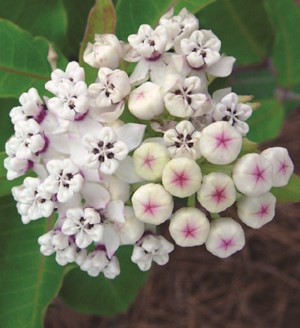
Redring milkweed
Adult Monarchs have a long, tubular mouthpart that allows them to feed on nectar from flowers. This sugary substance fuels their long journey south to their over-wintering sites in the Transvolcanic Belt of central Mexico. This mountain range serves as a corridor for migratory butterflies and is home to Oyamel fir trees, the preferred overwintering tree for Monarchs. These trees are native to the high altitudes of the Transvolcanic Belt of central and southern Mexico and western Guatemala.
During the winter, Monarchs congregate on these trees by the millions. During December and January, the Oyamel forests provide Monarchs with the sheltered, moist conditions necessary for survival. The clustering of thousands of butterflies on each branch also helps them maintain their body temperatures during freezing conditions and winter storms, although mortality levels are high during winter. Wintering Monarchs use their carbohydrate and fat reserves and do not feed on nectar.
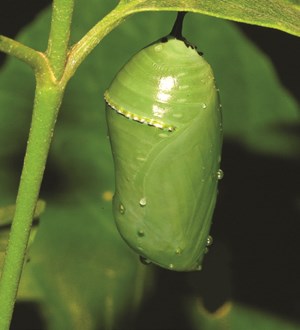
Chrysalis
When temperatures begin to rise in February and March, Monarchs rouse and actively search for water and nectar for replenishment. During warmer weather, the surviving Monarchs become reproductive-ly active and search for mates. Adult butterflies must be present in numbers great enough to find mates, have enough nectar to fuel migrations, and survive harsh over-wintering conditions. These butterflies then begin their journey north to northern Mexico and the southern United States. Once in South Texas, Louisiana, and Mississippi, the weary butterflies search for host plants on which to oviposit, or lay eggs.
The spring migration north from Mexico to Canada is a multi-generational one, meaning individual butterflies do not complete the entire journey, instead reproducing in a northward direction with their offspring making it farther and farther. After mating, female butterflies lay their eggs on plants in the milkweed family, which are the only plants Monarch caterpillars eat. This floral-faunal association makes milkweed availability throughout the migration path of Monarchs essential to their success. In Mississippi, milkweeds typically sprout in early March, just in time for the spring migrants to find as they journey north from Mexico. The first Monarch butterflies and caterpillars are usually spotted in late March or early April, and caterpillars can be found on milkweed plants through late May.
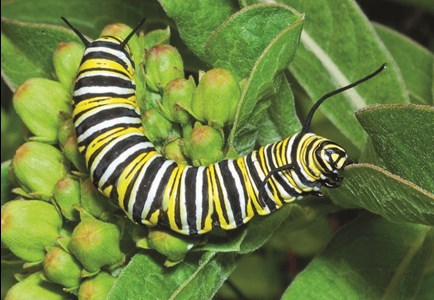
Caterpillar
Monarch butterflies undergo four stages as they metamorphosize from an egg to a caterpillar to a chrysalis (pupae) and, finally, to an adult butterfly. Each stage is accompanied by different requirements. Eggs must be properly positioned so that they are protected from the elements. Caterpillars must have enough plant material to eat and mature. The chrysalis must have a structure from which to hang, while being protected and disguised. Of course, each stage is susceptible to natural predation, so Monarchs have strategies to avoid predators. Because Monarch caterpillars feed on milkweeds, which are toxic plants, they are toxic throughout their lives. Mon-arch caterpillars and adult butterflies are brightly colored to signal their toxicity to potential predators.
Monarch butterflies have several unique life-history requirements that make them susceptible to human changes to the environment. The most obvious requirement for Monarchs is the food plant for their caterpillars – milkweeds. The most common species of milkweeds in Mississippi are green antelopehorn milkweed (Asclepias viridis) and butterflyweed (Asclepias tuberosa). Both can be found growing in fields and along roadsides, and carefully timed mowing can help ensure the availability of milkweeds during spring and fall migrations. These and other native milkweed species make excellent additions to flowerbeds and open spaces because they require little extra care and will almost certainly host hungry Monarch caterpillars.
To meet other requirements for Monarchs, especially those traveling through Mississippi, it is critical to maintain flowering plants throughout the spring, summer, and fall, as nectar sources for migratory adults. Nectar plants include not just milkweeds, but many other flowering plants, too, including goldenrods, sunflowers, and bonesets.
(click to enlarge)
Changes in agricultural practices in the United States, changes to climate patterns and intense weather events, and loss of Oyamel fir forests in Mexico also have had detrimental effects on the Monarch. The U.S. Fish and Wildlife Service (USFWS) was petitioned in 2014 to protect the monarch butterfly under the Endangered Species Act. Based on the petition’s information, the USFWS began an assessment with a final decision expected in June 2019. However, because of extreme effects climate had on the population in 2018, the deadline for a decision was extended by the Center for Biological Diversity and Center for Food Safety to December 2020.
“Monarch butterfly population sizes are incredibly vulnerable to climate change effects, so they are in urgent need of protection,” said Tierra Curry, a senior scientist at the Center for Biological Diversity in a May 2019 news release. “We need to take action now to avert climate catastrophe for butter-flies and all wildlife, as well as ourselves.”
To combat pressures faced by this and other declining insect species, it is recommended to create habitat wherever possible, including host plants and nectar plants, as well as limit the use of chemicals, including herbicides and pesticides. This will not only benefit Monarch butter-flies but other insects and interdependent species, including bats and songbirds.
Dr. Audrey Harrison is a Research Entomologist with the U.S. Army Engineer Research & Development Center in Vicksburg. If you would like to learn more, contact Dr. Harrison at audreybharrison@gmail.com.


